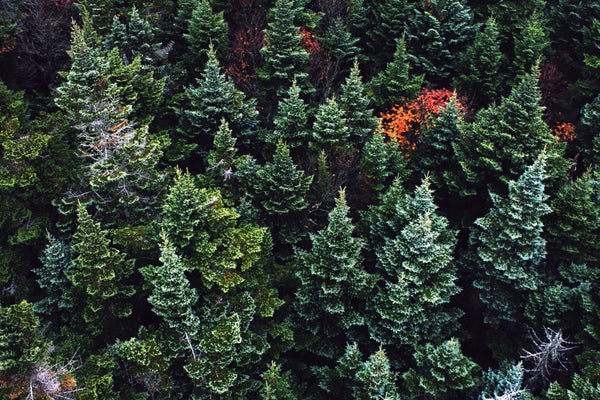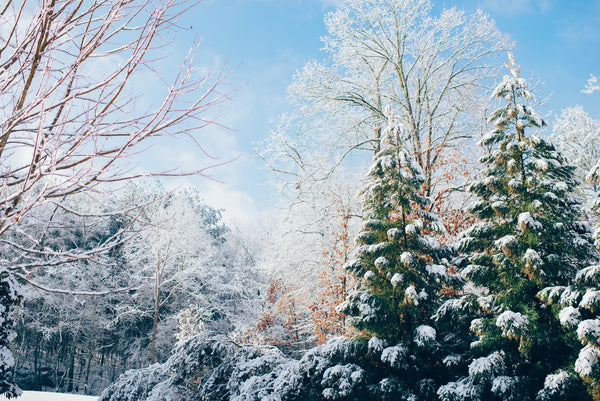Privacy Trees: they add curves to your garden while providing you with privacy from your neighbors and blocking out noise. They will also help protect your landscape from extreme weather conditionswhile improving the quality of airin your yard.
Proper planning is a necessary part of choosing the correct privacy trees for your yard. This guide serves as a tool tohelp ensure that the trees you buy and plant will flourishand be a part of your landscape for years to come.
Planning
Making a decision in haste can lead to a lifetime of disappointment. However, potential problems can be eliminated by proper planning. Take your time and select the trees that will give you all the qualities you desire.
Purpose
Will this tree just provide privacy, or will it also provide flowers and texture to yourgarden? Or will they provide a dark green back drop for your flowering shrubs in order to make your yard pop? Knowledge of what you are looking for will help you make your final selection when the time comes.
Area
Consider where you plan to plant your trees. How many feet do you need to cover? This will be especially important when determining how many trees you will need. You will also need to consider how much of your yard you plan to dedicate to this screen.
If you do not have a large yard, itwill make a difference on what size trees you choose. Yard size also affects how many privacy trees you need and how to space them. For dense hedges, we recommend spacing the trees about 2 feet apart. This applies to smaller trees, such as theEmerald Green Thuja. If you are planting larger trees, like theThuja Green Giants, then we recommend spacing them about 5 feet apart.

Growth
How tall does your privacy screen need to be? A tree’s growth rate will make a difference in your decision. Keep in mind that larger, fast-growing trees take off very quickly, getting very tall and wide. We do not recommend planting them near utility lines, buildings or sidewalks. Your trees may need regular pruning if planted near these structures.
It is also a good idea to plant trees where the roots systems have enough room to spread out. Some of these trees can grow upwards of 30 feet in height and beyond. As a result, their roots systems will need plenty of room to spread out. We do not recommend planting near underground irrigation systems like septic tanks.
And fast-growing trees typically have a shorter life span than other trees. Often times, rapid growth doesn’t give the tree enough time to produce strong root and branch systems. This can also make the trees more susceptible tostorm damage. While slow growing trees are stronger and will often survive for hundreds of years, they may not reach their mature heightduring your lifetime.
Care
Each tree hascritical needs forits care. Most trees thrive best in moist soil that’s slightly acidic. However, if you live in an area that does not have ideal soil conditions, you may need to add in organic or acidic planting mix when planting your trees.
Speaking of soil, it’simportant to know the pH balance of your soil prior to planting. Different trees require different soil pH levels.We recommend using a pH tester to determine the pH of your soil.
Testing your soil will let you know if your soil is more acidic or alkaline, and what type of fertilizers you will need to utilize in the future. When you test your soil, take several measurements in differentareas of your yard for a more accurate average value.
Watering is also important. Privacy trees need a sufficient amount of water. If you are unable water your trees regularly, then you may not want to plant privacy trees. You will need access to an ample water source, likea watering or sprinkler system. Privacy trees will also need plenty of sunlight. Most trees thrive in full to partial sunlight.
Existing Plants
If there are existing plants in the area, your new trees should have similar watering needs. For example, drought tolerant trees should be planted together and equally water dependent plants should be planted together.

Restrictions
Some Homeowners’ Associations and Private Covenants may place restrictions on what type of trees you plant. Be sure to check with them prior to making any purchases. Some states also have agricultural restrictions on specific trees. If you are unsure if the trees you are interested in arestate restricted, we recommend checking with your local Agricultural Extension. Government restrictions are not typically an issue.
Deciduous or Evergreen Trees?
Deciduous
These privacy trees lose their leaves in the fall and remain bare throughout the winter. However, the benefit to leaf loss is the lovely display of colors before their leaves drop. They also make some of the best shade trees. In the summer, these trees can block the sun from your windows, keeping your home cooler. This allows most people to save money on their AC bill.
And deciduous trees are able to help keep your home warm in the winter because they drop their leaves, giving the sunlight a chance to shine through the branches into your home. However, deciduous trees do need to spend more time and resources than evergreens replacing their photosynthetic system with nutrients.

Evergreens
Privacy trees such as Evergreens make wonderful additions to your yard, since they offer year-round coverage to areas like your bedroom and bathroom windows. Their dark green foliage also makes for a beautiful contrast against brick, birch and timber. Most Evergreens have scales or needles for leaves. Although, there are trees like the Magnolia that keep their leaves year-round and do not have needles.
Conifers, also known as Evergreens, can either grow very quickly or slowly, depending on the varieties you choose. This is why it is important to understand the tree’s growth rate. Evergreens will not stop growing after 10 years but may eventually slow over time.
Semi-Evergreen
There are some plants, such as theHydrangea, that are evergreens but drop their leaves during extremely cold winters and keep them when winters are mild. There are also some plants, such as Hornbeam Hedges, that will keep their older dead leaves until the following spring.
Size and Spacing
Consider the measurements of the area where you want to plant your trees. Different types of trees vary in height and width. You also need to consider the mature height you’recomfortable with in your yard.
When planting, it’s also a good idea to place your trees at least 10 to 15 feet away from your home or foundation. Furthermore, you’ll want to stay at least 4 to 5 feet away from patios, fences, and other structures. Remember, if you are planting underneath a utility line, you will want to select a short tree that will not reach more than 25 feet in height.
After you figure out your reason for planting privacy trees, you need to determine how high you want your privacy screen to be. This will also help you determine how much available space you have, and if you want a single or double row of trees. When you plant your trees in rows, they will not spread out as widely as they would if planted singularly.
Spacing is important because many privacy trees can reach soaring heights. Properly spacing the trees will ensure they get the nutrients they need to grow big and tall. You should plant privacy trees far enough apart so that they can reach maturity without any issues.
Spacing mainly involves the trees’ crown width. It is best to prevent crowding your trees’ root systems. You can achieve this by measuring your trees’ center 12 inches to 24 inches apart when planting. This can vary depending on type of trees you select to plant and how quickly they will grow to maturity.

Common Screening Problems
Uniformity
Homeowners often set out to plant a formal row of the same variety of tree to establish a uniformed look to their landscape. Plantings attempted this way often end up with one or more missing trees. Instead of planting one type of tree, you can try planting a mixture of trees and shrubs. This is especially effective for large to medium-sized spaces. Planting a mixture oftrees increases the diversity of your landscape. Also, itdecreases the spread of diseases andpests among trees planted in a row. And staggered row planting often looks more natural with mostlandscapes.
Staggered or cluster planting is done by planting trees in groups of threes, fives, or other odd numbers to block high winds or specific views. It will also help you provide attractive backgrounds for flowering and fruiting trees that are visible from your home, as well as allowing for good screening and airflow.
Planting
It’s best to plant your trees when the weather is cool or humid. If you are unable to plant right away, we recommend keeping your trees’ roots moist and placing them in cool, shaded and protected area. If you have bare-root trees, it’s best to soak them for 3 to 6 hoursprior to planting.
Trim away any plastic, burlap, or reinforcement wire from the root-ball. During this process, make sure that the root-ball stays intact and is undamaged. Break up and loosen the soil in the planting hole so the roots are able to break through.
Begin shoveling backfill into your hole. You will do this until the roots are completely covered and the majority of the backfill is used. Water your planting site as you fill the hole to remove any air pockets. Remove any rocks, weeds, or grass and break up any dirt clumps.
Once the trees are planted, water them again. In order to keep the roots warm and moist, place 2 to 3 inches of mulch around your tree. The mulch should be about 3 to 6 inches away from the bases of your trees.Mulch also helps moderate soil temperatures and keeps the ground warm during winter, cool in the summer and keeps the weeds at bay.
Water your trees well during the first few weeks. The watering frequency will depend on your soil types. Soil that is moist and holds together will not need much water. Mulching helps retain moisture and reduces watering frequency. Give your trees extra water duringextended dry periods, even during the winter. Providing the trees with a good supply of moisture will prevent damage
to the root system.
Fertilizing
Don’t fertilize your trees until they’ve experienced one year of growth in their new location. Do not put fertilizer in the planting hole during the transplant, as it may cause root injury. Organic fertilizers are best for your trees because they are less harmful than inorganic fertilizers, and they come from all-natural animal and plant sources.
Adding in fertilizer that containsnitrogen can help increase your trees growth rate. You can apply between 0.10 and 0.20 pounds of nitrogen around your tree per 100 square feet. However, make sure to read the label prior fertilizing your trees.
Do not allow the fertilizer to get on the leaves and stems of your tree. You can either drop or scatter fertilizer under the tree’s canopy. You do not have to remove the mulch around your tree prior to fertilizing.
Ingredients such as leaf mold, sawdust, manure, peat moss, and pine bark can actually improve your soil and add in key nutrientsyourtrees need. Make sure to look for these key ingredients when shopping for a fertilizer. Unless your trees need additional potassium or phosphorus, it is best to stick with fertilizers that are higher in nitrogen.
Young trees should ideally be fertilized during the growing season, after they’ve experienced one year of growth. Trees should be fertilized after the final frost in your area. Depending on your zone, this can be done in early April until early June. Fertilizing helps the trees ward off infections and get over any mineral deficiencies theymay have.
Note:Evergreen or conifer trees rarely need fertilizer. Unless you normally fertilize your lawn, you can skip fertilizing yourtrees.
Pruning Privacy Trees
Newly planted trees do not need a lot of pruning. In fact, we only recommend pruning off dead or diseased branches. Beforemaking any cuts to your tree, remember that poor pruning can cause damage that will last forever on the tree.
When pruning your tree, make any cuts outside the branch collar – this way, you will not damage the trunk. Maintaining the trunk’s health is essential because this is where the internal decay starts.
Small branches are typically easier to prune. However, if you must prune off a larger branch, be sure to prune it back to a secondary branch or bud. Use caution when pruning this way. Any cuts made in between buds and branches can also lead to decay.
Young trees have a single dominant leader stem that grows upward. Be carefulnot to prune the tip of this dominant stem. Some trees will grow double leaders or co-dominant stems. It is best to prune or remove one of the stems to prevent structural weakness in your tree.
The most important thing to remember when pruning: do not remove too many branches, especially when the tree is young. Keep in mind that the branches help the tree with food production and storage. If you prune too much of yourtree’s canopy over time, it can cause growth issues.


